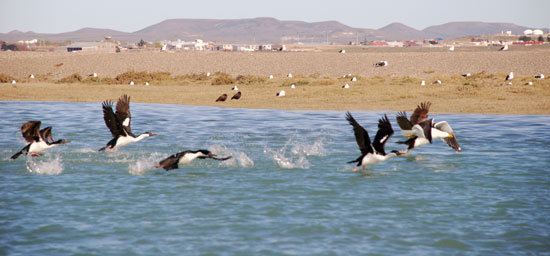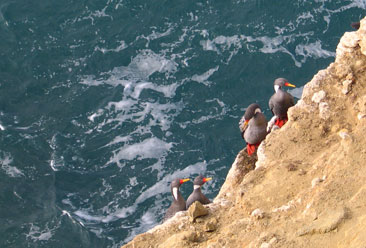The natural richness of the bay of San Julián See map
The great diversity of species on the coast makes of Puerto San Julian a site with great potential for tourism as a few places in the province have, where it was created the Natural Reserve of San Julián Peninsula on the eastern shore of the bay, 25 km from the city.
The place has more than 10,000 hectares in which you can see endemic species of the steppe, such as the guanaco, rhea, red fox, gray fox and piche, of the marine wildlife such as frinedly
Commerson's dolphins and Magellanic penguins and of the coastal and marine birds as biguas, imperial and black neck cormorants.
 In St. Julian's Bay it can be spotted birds of different species. Photo courtesy of Tourism Office of Puerto San Julián.
In St. Julian's Bay it can be spotted birds of different species. Photo courtesy of Tourism Office of Puerto San Julián.
The Reserve was created in 1986 to conserve and manage wildlife and their habitats, restore and maintain soil and pasture, reintroduce native species in different habitats, the scientific study of existing species and to identify places for tourism.
Moreover, there are two non-breeding sea lion colonies in the vicinity of the city. One is located 23 km north near beach La Mina, consisting of 250 South American sea lions, while the other seal colony is in the south of Puerto San Julian, on the beaches of the stay Makenke, which consists of about 600 specimens of the same species plus about 70 sea elephants.
 Grey Cormorant on the cliffs.
Grey Cormorant on the cliffs.On the inner roads of the bay you can see four species of cormorants that inhabit the Atlantic coast: shag cormorant, rock cormorant, bigua cormorant and grey cormorant, the latter being the largest in our country.
Also you can look at the Magellanic penguin, the heron, the kelp gull, the austral gull, the red beak tern, the great grebe, the Antarctic pigeon, the black oster, the skuas and the petrels.
Both the Magellanic penguin as kelp gulls and bigua cormorants nest in the so called Cormorante Bank, reaching a nesting area of 98 hectares, where it is estimated a 120,000 colony of Magellanic penguins (the third largest provincial-level after Cabo Virgenes and Monte León). This place is just 1 km from the city, thus it is common to see penguins on the beaches of the urban sector or in the streets of the city that do not react to human presence.
Other important sites are the Justicia Bank whre nest shags and rockers, and the area called "La cascada", by the existence of a small waterfall, fed by the ebb and flow of tides, where there is a unique concentration of birds like the flamingo, the coscoroba swan, black-necked swans, common geese, juarjual ducks, cappuccino ducks, corn ducks, ginger ducks, steam ducks, rumped sandpipers ducks, brown sea and pitotoi.
All these activities can be performed from September with the arrival of the Penguins and end in April with the decline in the number of species that can be spotted, and coinciding with the end of the season.
Viajes por la Patagonia
Related Articles
© Patagonia.com.ar 2025 | Todos los derechos reservados.
